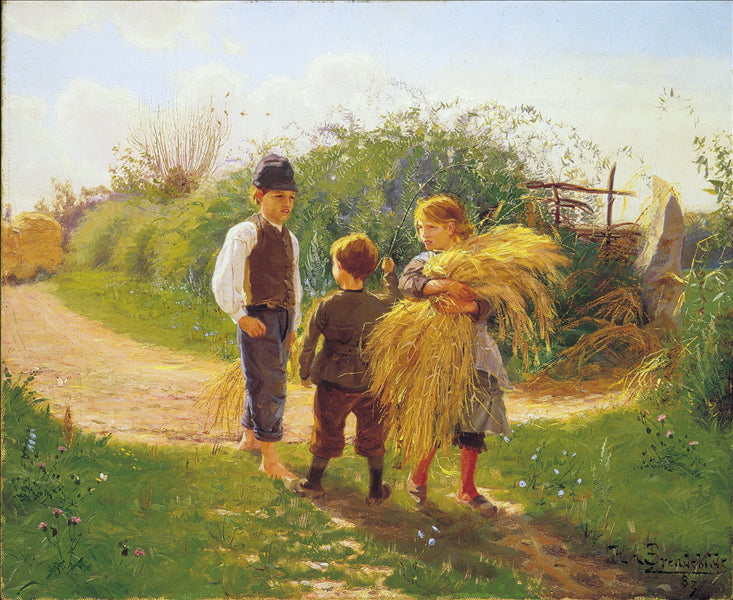Description
The work "Children collecting remains of harvests" by Hans Andersen Brendekilde, painted in 1883, is erected as a moving testimony of rural life and childhood in the context of the development of Danish art in the second half of the nineteenth century. Brendekilde, known for his focus on social issues and his sensitivity towards the living conditions of the least favored, plasma in this painting a moment of work and child curiosity that transcends the mere representation of nature.
The composition of the work is remarkable for its simplicity and at the same time its narrative effectiveness. At first glance, we see a group of children in a field, with their bodies in different positions that suggest an active search for the remains of the harvest. The diagonal arrangement of the characters, which move asymmetrically through the canvas, guides the viewer's gaze towards the bottom, where cultivation fields are glimpsed, hinting at a connection with the agricultural work that transcends the moment represented. This spatial organization not only reflects the dynamics of the action, but also creates a sense of depth that invites you to explore the rural environment.
The use of color in this work is another of its most striking aspects. Brendekilde opts for a palette that evokes the warmth of natural light. The yellow, green and brown tones predominate, suggesting a sunny day and emphasizing the vitality of the field. Children, dressed in colored clothes off, melt with the earth and the environment, symbolizing their connection with nature. The texture of the landscape, almost palpable, is complemented by the soft representation of child skin, which contrasts with the rusticity of the field.
The painting characters are, without a doubt, the focus of attention. Although children's faces are mostly in shadow, expressions of concentration and effort are perceived. His actions, ranging from collection to curiosity, reveal the innocence and joy of childhood, offering a delicate balance between work and game. This duality is characteristic of the art of Brendekilde, who often portrays daily life with a tender but realistic approach. The work is also framed in a social context in which rural childhood faces the hardness of work in the field, which suggests a reflection on the loss of childhood in the search for subsistence.
Brendekilde was one of the artists who contributed to the rise of realism in Denmark, a movement that focused on the truthful representation of everyday life and social conditions. paintings As "children collecting remains of crops" are aligned with this approach, where the image of childhood in a rural environment becomes a reflection of the social reality of their time. His sensitivity to child labor and pastoral life can be related to contemporary artists who explored rural life, providing a visual dialogue among their works.
In Brendekilde's work, the combination between realistic art and emotionality in the representation of childhood underlines its ability to capture the essence of a fleeting moment, which, over time, resonates with the contemporary spectator. "Children collecting remains of crops" remains a vibrant reminder of simplicity and beauty found in everyday life, inviting a reflection on the value of children's experience and interactions with the world around us. With his polished technique and his deep sense of humanity, Brendekilde consolidated not only as a Danish rural life chronicler, but like a master capable of transmitting the universality of the human condition through its art.
KUADROS ©, a famous paint on your wall.
Hand-made oil painting reproductions, with the quality of professional artists and the distinctive seal of KUADROS ©.
Art reproduction service with satisfaction guarantee. If you are not completely satisfied with the replica of your painting, we refund your money 100%.

